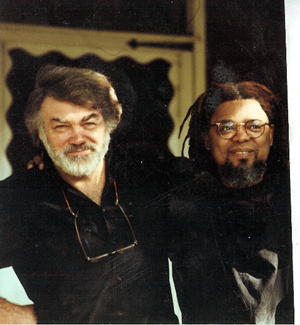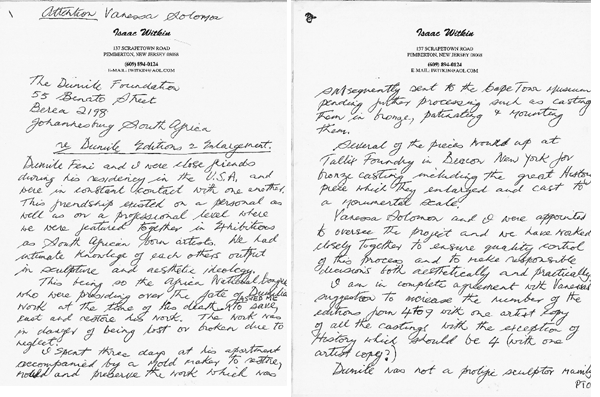Dec 13, 2025
Dec 13, 2025
 However, in his own lifetime, Isaac Witkin was preoccupied with making sure the work of his South African friend and fellow sculptor, Dumile Feni, rather than his own, would get the recognition it deserved. Although he struggled terribly as an artist in the United States, Isaac helped him in every way.
However, in his own lifetime, Isaac Witkin was preoccupied with making sure the work of his South African friend and fellow sculptor, Dumile Feni, rather than his own, would get the recognition it deserved. Although he struggled terribly as an artist in the United States, Isaac helped him in every way.
After Dumile's sudden passing, Isaac along with foundry owner John Phillips, went to great lengths to make sure that his good friend's creativity would not be lost to the world, by helping to salvage Dumile's molds and unfinished castings.
The following letter written by Isaac to the Dumile Foundation is an example of Isaacs's concern for his fellow South African artists, and how he continued to preserve Dumile's legacy '

'Dumile Feni and I were close friends during his residency in the USA and were in constant contact with one another. This friendship existed on a personal as well as on a professional level where we were featured together in exhibitions as South African born artists. We had intimate knowledge of each other's output in sculpture and aesthetic ideology.
This being so, the African National Congress who were presiding over the fate of Dumile's work at the time of his death asked me to save, cast and restore his work. The work was in danger of being lost or broken due to neglect.
I spent three days at his apartment accompanied by his mould maker to restore moulds and preserve the work which was subsequently sent to the Cape Town Museum pending further processing such as casting them in bronze, patinating and mounting them.
Several of the pieces wound up at Tallix Foundry in Beacon, New York for bronze casting including the great History piece which they enlarged and cast to a monumental scale. Vanessa Solomon and I were appointed to oversee the project and we have worked closely together to ensure quality control of this process and to make responsible decisions both aesthetically and practically.
I am in complete agreement with Vanessa's suggestion to increase the number of editions from four to nine with one artist copy of all the castings with the exception of History which should be four (with one artist copy?)
Dumile was not a prolific sculptor mainly due to financial limitations. Many of his pieces were lost or destroyed because of his many moves from country to country and apartment to apartment. We are indeed lucky to have what we have of his work.Knowing Dumile as I did, I am certain that he would have approved this. He would have welcomed the chance to disseminate his vision more widely and on a more practical level he would not have been against making some money out of his art.
As a former assistant of Henry Moore, I know that some of Henry's editions were as high as fifteen with no apparent lessening of value. In the case of Rodin, editions were illegally exceeded posthumously due to the foundry's exploration of old molds they had in their possession and laxness of control.
This would not be the case with Dumile's work. I have implicit faith in the integrity of Tallix foundry who's Director Peter Homstead is a good friend of mine and Vanessa who will oversee the quality control of every cast.
Because there has not yet been a definitive decision carved in stone regarding the edition for proposal, nothing has been violated.
Regarding the authenticity of the enlargement of the History piece and the reference drawn with the sculpture of Renoir attributed to another sculptor, the comparison stops there. Renoir's sculpture depended on their sensual tactile surface for their vibrant sensuality. In the case of Dumile's sculpture the touch is less important as the surface is smooth and neutral. Anybody with the mechanical technical skill of the enlargement process could have carried this out.
Dumile in my opinion is one of the greatest sculptors to have emerged from South Africa of the last century and is the legitimate heir to extending the mainstream tradition of African Art.
As his friend and admirer, I hope that he receives his just recognition and I feel sure that this is the direction to go in to achieve this end.'
As a South African expatriate whose work was often inspired, either subconsciously or more directly, by his native land, Isaac Witkin was sometimes invited to speak on African Art. He expressed his appreciation and reverence for African Art in an essay commissioned by the Museum of African Art in New York for their May 1994 exhibit 'Artists collect African Art'. Witkin wrote that 'one cannot divorce aesthetic qualities from the cultural conditions that generated it. It is necessary to remember the African carver who would discard his work if the spirit has not entered it.' He added that 'the greatest achievement in African Sculpture is due to the sculptor's belief in a higher power and their closeness to it.'
Previous Page
Continue Next Page
20-Jul-2008
More by : Dr. Amitabh Mitra